| The
Voice is silent. |
 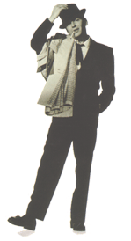 |
|
| "In
that spotlight, treading the boards in his patent-leather party shoes, winging
the microphone around as he made love to his own voice, ... he was the godfather
of the musical depths of their sorrows, their lonely nights, their passionate
silliness," wrote self-described "junior Rat Pack member"
Shirley MacLaine in "My Lucky Stars: A Hollywood Memoir." Sinatra was born Dec. 12, 1915, the only child of working-class Italian-American immigrants, in a tenement at 415 Monroe St. in Hoboken. His father, Anthony, was a boxer-turned-fireman; his mother, Natalie "Dolly" Sinatra, was a former barmaid who often sang at family gatherings. Their home and their neighborhood rang with the sweet sounds of the Italian bel canto style of singing; the boy drank it in through his pores, then sang along. |
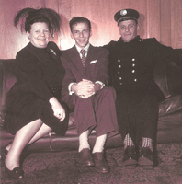 Frank with his mother Dolly and father Anthony.
|
|
| Sinatra dropped out of high school at 15 and decided he would follow in the footsteps of his idol, Bing Crosby. In 1935 he entered a radio talent program called Major Bowes Amateur Hour. For the performance Frank partnered up with a singing and dancing trio called the Three Flashes and formed the Hoboken Four. They won first prize and went on to more performances with Major Bowes' traveling show. Within a few years, Sinatra was singing regularly on several radio stations. He got his big break while working as a singer and waiter at an Englewood, N.J. restaurant, the Rustic Cabin. There, trumpet extraordinaire Harry James found the young Sinatra and decided he would fit well as the lead singer for his band The Music Makers. |
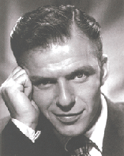 |
|
| Sinatra quit James’ band after 7 months and joined Tommy Dorsey's swing orchestra. It was with Tommy Dorsey’s orchestra that the classic Sinatra crooning began and the idol began to form. By the early forties Sinatra had made a name for himself and he bought out his contract with Dorsey to pursue a solo career. Success followed him and so did swarms of adoring teenage girls just to hear his unique phrasing and emotional performances.
|
|
|
|
During
his years with Dorsey Sinatra made his first film appearances, in ' Las
Vegas', &'Ship
Ahoy' (above). |
||
The first Frank Sinatra hit song was recorded in 1939 with the Harry James Orchestra. "All or Nothing at All," was actually released in 1943 after Sinatra had left James’ group and signed on with Tommy Dorsey’s Big Band. The tough
times began in the early 1950s. In 1951, Frank left his first wife Nancy
and his three children for movie starlet, Ava Gardner. Their five-year
relationship was a precursor to the more modern tabloid headline grabbers
of today. In 1952, Sinatra suffered a severe blow to his career when his
vocal cords hemorrhaged. At this point in his career the music was painful
and the movie roles were poor. Professional abandonment came for Sinatra
at age 37 when he was dropped by Universal, CBS-TV, Columbia Records and
his agent. |
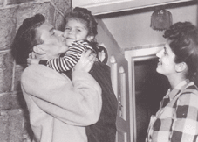 Frank with wife Nancy & daughter Nancy. |
|
| The downhill road began to show incline thanks to Ava Gardner’s assistance in securing husband Frank the role of Angelo Maggio in 1953's From Here to Eternity. Sinatra himself loved the role and knew he was born to play it. He fought hard to convince the producers the same and even agreed to take a huge pay cut and take the role for only $8,000. His performance as Maggio opposite Burt Lancaster and Donna Reed showed that he could hang with the big boys of Hollywood. The fitting reward for his dramatic performance was the Best Supporting Actor Oscar for his work in the film. | 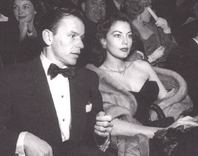 Frank with Ava Gardner, 'the love of his life!' |
|
|
|
In 1953, Sinatra’s musical career was reborn when he signed on with Capitol Records. His collaborations with arranger Nelson Riddle produced some of the most popular albums of the time, such as Songs for Young Lovers, A Swingin' Affair, Come Fly With Me, Swing Easy, In the Wee Small Hours, and Songs for Swingin' Lovers. During this period Sinatra went through a vocal evolution from the crooning heartthrob to the more mature and interpretive artist. He covered the gamut of emotions with his albums and pulled it off each time. He described his bipolar accuracy with the quote “being an 18-karat manic-depressive and having lived a life of violent emotional contradictions, I have an over acute capacity for sadness as well as elation.” The hit songs kept coming and the persona and success ballooned during Sinatra’s so called “come-back” in the late ‘50s. Yet, it’s hard to call it a comeback when he ended up surpassing where he had been in the first place. It was more like a come back followed by unbelievable yet well-deserved achievement. He was back at the top of the music, movie and even TV world. Entertainment was synonymous with Sinatra. Here the legend took form as a result of the way he handled himself during such fruitful times. Always cool and collected, he carried himself in a way that most in the limelight do not.
|
|
He
worked hard to maintain the standards he set with sold-out concerts, hit
records, and popular films and television specials. "The Chairman
of the Board" added successful businessman to his resume with many
successful deals including the co-founding of his own recording label
in 1961 dubbed Reprise Records. The up and down love affair/marriage with
Ava Gardner ended in divorce in 1957. Sinatra the bachelor was back and
he pursued such Hollywood sex symbols as Elizabeth Taylor, Judy Garland,
and Lauren Bacall. He ended up marrying the little known actress Mia Farrow
(30 years his junior) in 1966. They divorced in 1968 and in 1976 Sinatra
married his fourth and final wife, Barbara Jane Blakely Marx, Zeppo Marx's
widow. |
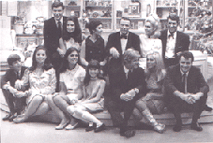 A fusion of families in the 1967 Dean Martin television show. back row: Frank Junior, Tiina Sinatra, Dean Martin, Frank, Mrs. Dean Martin and Dean. front row: The martins-Ricci, Gail, Claudia and dean Junior, nancy Sinatra, and Craig Martin. |
|
Sinatra announced his retirement from both recording and acting in 1971. He was far from finished, however, and in 1973 released the television special and album, Ol' Blue Eyes Is Back. In 1980 he appeared in the urban crime drama The First Deadly Sin. He appeared sporadically on TV (Who’s the Boss and others) and in film throughout the ‘80s. n 1988 Sinatra launched a hugely successful Rat Pack reunion tour with Sammy Davis, Jr. and Dean Martin but when Dean pulled out due to the strenuous schedule, Liza Minnelli provided a very qualified replacement. The release of two albums featuring Sinatra with other popular artists of the times, Duets (1993) and Duets II (1994), proved his style of music was still in demand. The two Duets albums outsold any of his albums. Frank proved he could cross-generational barriers with as much ease as he sang a song. |
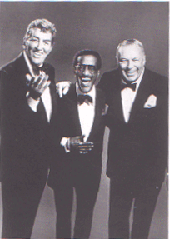 |
|
| The
rat Pack trio in advance of their last proposed 29-city tour in 1988. |
||
| Many people overlook the generosity of Frank Sinatra throughout his life. He was a favorite of the media due to his alleged mob ties and the focus usually centered on what he did wrong instead of the many things he did right. In 1971, the Motion Picture Academy awarded him the Jean Hersholt Humanitarian Award for his many charitable deeds. He received the Kennedy Center Life Achievement Award in 1983 and the Presidential Medal of Freedom in 1985. In 1987, Sinatra was awarded a Lifetime Achievement Award by the N.A.A.C.P. If any of those accolades can be topped, they were in 1997 when Frank Sinatra received the highest honor the U.S.A. can bestow upon a civilian in a Congressional Gold Medal for his countless accomplishments as a singer, actor, and humanitarian. | 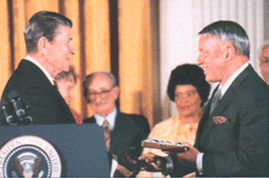 |
|
| President
Reagan awards Sinatra with the Presidentail Medal of Freedom, 1985. |
||
|
|
Frank Sinatra passed away as a result of a heart attack on May 14, 1998 at the age of 82.
|